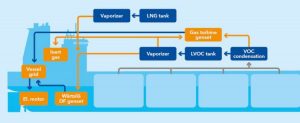Setting new, ambitious environmental standards for shuttle tankers

Our new generation of “E-Shuttles” use their own emissions as fuel. Once on the water, they will be the most environmentally friendly shuttle tankers ever built.
The research and development of our latest innovative, eco-friendly concept tankers began in 2016. Since then, we have placed an initial order for two Suezmax-size, DP2 shuttle tankers at Samsung Heavy Industries (SHI) in July 2017, followed by two more in November 2017. Upon delivery in 2020, these vessels will join Teekay Offshore’s Contract of Affreightment (CoA) fleet in the North Sea.
Amongst other new features, the design concept incorporates several of Wärtsilä’s new technologies. The annual emission reduction potential is estimated at up to 42%, with fuel consumption reduced by up to 22% compared to traditional shuttle tankers.
Technology highlights:
- Annual CO2 emissions reduced by 42%
- Annual NOx emissions reduced by more than 80%
- Annual SOx emissions reduced by more than 95%
- Annual fuel consumption reduced by 22%
How it works:

Photo: DNV GL, Wärtsilä, Teekay
Our new “E-Shuttle” tankers will operate on both liquefied natural gas (LNG) as the primary fuel, and a mixture of LNG and recovered volatile organic compounds (VOCs) as secondary fuel.
VOCs are produced in a gaseous state from evaporation occurring in the oil cargo tanks. This new mixture enables our new shuttle tankers to travel from the oil fields on their own waste gas rather than releasing it into the atmosphere. This will reduce both emissions and bunkering requirements considerably. In fact, by reusing those VOCs as a fuel, the annual emissions can be reduced by 42 per cent. But the positive benefits don’t stop there. The new hybrid system also has a direct positive impact on the main machinery operation, resulting in fewer running hours and consequently lower maintenance time and costs.
Together with the electric propulsion system, it reduces the required total mechanical installed power by 14%, increasing the overall fuel performance compared to traditional power distribution concepts.
We are excited to set new standards for both fuel consumption and CO2 emissions for our industry. Our efforts are featured on the Explorer.no, the digital showroom for Norwegian green and sustainable solutions.